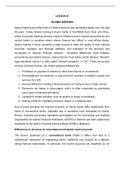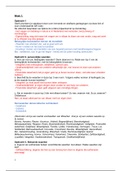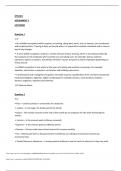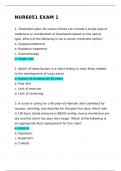LESSON IX
ISLAMIC BANKING
Islamic banking and other forms of Islamic finance have developed rapidly over the past
50 years. Today, Islamic banking is found mostly in the Middle East, Asia, and Africa,
where it provides banking services mostly to Moslems and to several governments and
central banks in countries where Islamic finance has official or semi-official status.
Islamic finance in some countries is large enough to affect the quality of their national
accounts, monetary and financial statistics, and indicators of the structure and
soundness of national financial systems. Important differences exist between
conventional and Islamic finance. Islamic finance must follow certain Moslem “Shariah”
legal standards, hence it is often called “Shariah-compliant”, or “SC”. There are several
schools of Islamic finance, but certain general principles are;
1. Prohibition on payment of interest or other fixed returns on investments,
2. Encouragement of investment in real economic activities or trading in goods and
services for profit,
3. Avoid profiting from trading in financial assets or “using money to make money”
4. Excessive risk taking is discouraged, which is often interpreted as prohibiting
many types of financial derivatives,
5. Lending for certain activities, such as alcohol or drugs, is prohibited,
6. Sharing profits for charitable purposes “zakah” is a religious duty,
Due to these practices the financial accounts of Islamic banks differ significantly from
those of conventional banks. Separate sets of standards have developed for Islamic
finance including accounting standards promulgated by the Accounting and Auditing
Organization for Islamic Financial Institutions (AAOIFI) in Bahrain and bank supervision
standards by the Islamic Financial Services Board (IFSB) in Malaysia.
Differences in structure of conventional and Islamic bank accounts
The income statement of a conventional bank (Table I) differs from that of a
nonfinancial corporation by highlighting banks’ traditional core function as a deposit-
taking financial intermediary. In particular, the income accounts are headlined by net
, interest income (interest receipts less interest payments). That is, the bank receives
interest on its funds lent and pays interest on funds received from depositors. By
lending funds, the bank acquires a claim on the borrower for repayment of the amount
lent plus interest. By receiving funds from the depositor, the bank incurs a liability to
repay the deposited funds plus interest. The income statement of a conventional bank
typically shows net interest as a separate line item at the top of the accounts. That is,
the top lines separately list interest receipts, interest payments, and net interest receipts
less payments.
Other revenue for banks (typically called noninterest income) are shown below the net
interest line. The sum of net interest and noninterest income is the gross income of the
bank. Other expenses are subtracted from gross income to derive income before
income taxes, which can also be thought of as net operating income. Expenses consist
of noninterest expenses (salaries, office expenses, utilities, etc.) and provisions for loan
losses. Taxes on income are then subtracted from net operating income to derive net
income. Dividends are paid from net income, leaving retained earnings which are then
carried over to the balance sheet as part of equity.
Table I: Income statement Extract- Conventional Banking
Revenues
Net Interest Income
Interest Income XXX
Less: Interest Expense XXX XXXX
Add: Non-Interest Income XXX
Gross Income XXXX
Less: Non Interest Expense XXX
Provision for Loan loss XXX
Income Before Income tax XXXX
Less: Income Tax XXX
Income After Tax XXXX
Less: Dividends XXX
Retained Earnings XXXX
ISLAMIC BANKING
Islamic banking and other forms of Islamic finance have developed rapidly over the past
50 years. Today, Islamic banking is found mostly in the Middle East, Asia, and Africa,
where it provides banking services mostly to Moslems and to several governments and
central banks in countries where Islamic finance has official or semi-official status.
Islamic finance in some countries is large enough to affect the quality of their national
accounts, monetary and financial statistics, and indicators of the structure and
soundness of national financial systems. Important differences exist between
conventional and Islamic finance. Islamic finance must follow certain Moslem “Shariah”
legal standards, hence it is often called “Shariah-compliant”, or “SC”. There are several
schools of Islamic finance, but certain general principles are;
1. Prohibition on payment of interest or other fixed returns on investments,
2. Encouragement of investment in real economic activities or trading in goods and
services for profit,
3. Avoid profiting from trading in financial assets or “using money to make money”
4. Excessive risk taking is discouraged, which is often interpreted as prohibiting
many types of financial derivatives,
5. Lending for certain activities, such as alcohol or drugs, is prohibited,
6. Sharing profits for charitable purposes “zakah” is a religious duty,
Due to these practices the financial accounts of Islamic banks differ significantly from
those of conventional banks. Separate sets of standards have developed for Islamic
finance including accounting standards promulgated by the Accounting and Auditing
Organization for Islamic Financial Institutions (AAOIFI) in Bahrain and bank supervision
standards by the Islamic Financial Services Board (IFSB) in Malaysia.
Differences in structure of conventional and Islamic bank accounts
The income statement of a conventional bank (Table I) differs from that of a
nonfinancial corporation by highlighting banks’ traditional core function as a deposit-
taking financial intermediary. In particular, the income accounts are headlined by net
, interest income (interest receipts less interest payments). That is, the bank receives
interest on its funds lent and pays interest on funds received from depositors. By
lending funds, the bank acquires a claim on the borrower for repayment of the amount
lent plus interest. By receiving funds from the depositor, the bank incurs a liability to
repay the deposited funds plus interest. The income statement of a conventional bank
typically shows net interest as a separate line item at the top of the accounts. That is,
the top lines separately list interest receipts, interest payments, and net interest receipts
less payments.
Other revenue for banks (typically called noninterest income) are shown below the net
interest line. The sum of net interest and noninterest income is the gross income of the
bank. Other expenses are subtracted from gross income to derive income before
income taxes, which can also be thought of as net operating income. Expenses consist
of noninterest expenses (salaries, office expenses, utilities, etc.) and provisions for loan
losses. Taxes on income are then subtracted from net operating income to derive net
income. Dividends are paid from net income, leaving retained earnings which are then
carried over to the balance sheet as part of equity.
Table I: Income statement Extract- Conventional Banking
Revenues
Net Interest Income
Interest Income XXX
Less: Interest Expense XXX XXXX
Add: Non-Interest Income XXX
Gross Income XXXX
Less: Non Interest Expense XXX
Provision for Loan loss XXX
Income Before Income tax XXXX
Less: Income Tax XXX
Income After Tax XXXX
Less: Dividends XXX
Retained Earnings XXXX





